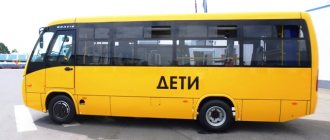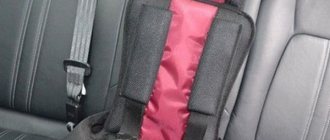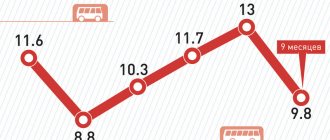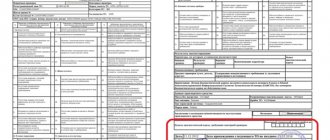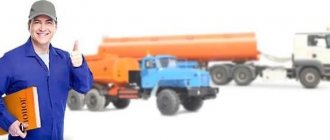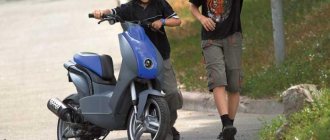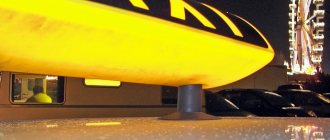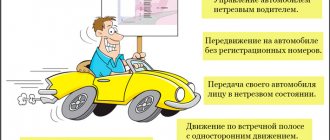Penalties for using/non-using a booster
Since the Rules do not mention this term, it is also absent from the Code of Administrative Offences. Regarding the rules for transporting children, there is a general rule (Article 12.023, Part 03), which states that a corresponding violation will result in a fine of 3,000 rubles.
If the inspector records that your child, who has not reached school age, is being transported without using restraints, regardless of the location, you will be punished. As in the case of transporting a 7-11 year old child placed in the front seat without a booster or car seat.
As for children over 12 years old, they can be transported in the cabin on a general basis, that is, they must be fastened with a seat belt, otherwise they will face the same fine.
From the point of view of the Rules, it is unacceptable to transport children in an unfastened state in a booster seat or car seat. Having an unsecured booster is also punishable by a fine if its design provides for fixation.
We also note that automatic recording of this violation is not provided, as is the evacuation of vehicles to the impound area when a violation is recorded by a traffic inspector. This fine is subject to a benefit that allows you to pay only half of it, provided that the debt is repaid within 20 days from the date of the decision.
There are two features regarding violation of the clause of the rules regulating at what age children can be transported in a booster seat:
- recording this violation is allowed as many times in a row as desired, the car owner is not given the required 24 hours to eliminate the violation;
- if you transport two or more children without restraints, the fine will still be 3,000 rubles, since in this case the very fact of transporting children with traffic violations is subject to punishment.
Booster and traffic rules
Neither the latest edition of the rules, adopted in the summer of 2021, nor even the earlier versions, mentions the words “booster”.
The rules for transporting children in this landmark document are regulated by clause 22.09. To be fair, we note that there is not a single word in it about other similar devices, from special children’s adapters to chairs.
The following terminology is used here, which may be perceived as too vague and ambiguous:
- child restraint,
- retention system.
Interestingly, the Rules do not clarify whether these terms should be understood as one thing or whether they are different devices for transporting children.
Here is an excerpt from paragraph 19.01:
Transportation of children under seven years of age, carried out in the passenger compartment of a passenger vehicle or truck cabin, if their design provides for the presence of seat belts along with an Isofix-type child restraint system, should be carried out with the mandatory use of CRS or devices, the design of which must correspond to the anthropometric data of children.
Let us note that in the context of the traffic rules clause, the Isofix child restraint system is mentioned, which complies with the Technical Regulations of the Vehicle in terms of the safety of wheeled vehicles.
Exactly the same wording is given in relation to the transportation of children of the next age category (within 7-11 years), but with a clarification: a child is allowed to be in the front seat of a vehicle, who is secured only with the use of restraints/devices designed for weight parameters and height characteristic of this group. In other words, children in the front cannot yet wear factory seat belts.
The rules also stipulate that the installation of such restraint systems intended for children in a vehicle, as well as media placement methods in such devices, is carried out in accordance with the user manual for these devices.
So, what do we have in accordance with the latest edition of the traffic rules:
- children under 7 years of age must be transported only using a CRS, regardless of location;
- children 7-11 years old, located in the back seat, can be fastened with standard seat belts, but in front, the presence of DUMS is mandatory;
- starting from the age of 12, the need to use a CRS completely disappears.
If we understand a booster as a child restraint system, then you will receive a comprehensive answer to the question of whether it is possible to transport a child in a booster and up to what age.
A little personal
Not much is known about Booster’s biography from Twitch - the young man does not talk too much about personal topics, so finding reliable data is quite difficult. Let's talk about what is known for sure:
- Born in Moscow, February 25, 1997;
- Real name: Vyacheslav Leontyev;
- As a child, he loved to play computer games - which his parents did not allow him;
- Whenever possible, I turned on the computer and started playing through various toys;
- He communicates closely with such streamers as Evelon192, DmitriyLixx, Karavay;
- In his free time he likes to travel and smoke hookah with friends.
Distinctive features of Booster's style from Twitch in the photo are the white Nike headband that he constantly wears on his head, practically without taking off his transparent aviator glasses. In recent streams, he even put glasses and a headband on his girlfriend and said that she now looks a lot like him! Another interesting distinctive feature is the butterfly stance, which the young man actively demonstrates several times per stream, with or without reason.
Buster from Twitch is familiar to most users of the platform with his phrase “Appreciate your mother.” Even now there is a small comic verse in the streamer’s profile:
“It’s always easy to offend a mother. She won't notice the insult. And he can only tell you: “Don’t catch a cold, it’s windy today.”
The girl's name is Ekaterina Bulankina - she is from Moscow, born on May 28, 2000. He talks a lot about his life on Instagram - you can see his profile here https://www.instagram.com/ekatze007/.
Fastening
Much depends on how the booster is mounted in the car. Here, surprisingly, there is no monotony either. There are models that do not have their own means of fastening at all: they are placed on the passenger seat, like a child car seat, secured with a standard belt (its unused longitudinal part). This is both inconvenient and unsafe, since during sharp turns and even when falling into a hole, the child risks falling out of such a chair with all the ensuing consequences. Isofix and Latch fastenings are considered the gold standard in this regard.
When choosing a booster, listen to the following recommendations:
- Go to the store with your child, let him personally evaluate how comfortable he will be in such a chair. It is worth trying several models with similar characteristics that suit you;
- choose boosters with high armrests, as they can reduce the pressure on the torso from the belt in case of an emergency;
- When the baby is in the booster, the belt should not touch his face - this is not even advice, but a requirement;
- do not choose a very high seat - this increases the likelihood of the child’s head colliding with the glass even during sudden braking;
- If there is a bus on sale equipped with a backrest with a support function, rest assured that it will be the most comfortable for your child.
We all know that every production area has its own leaders. There are some among the manufacturers of children's boosters, and we consider it necessary to acquaint our readers with them. Typically, the production of such devices is carried out by companies specializing in the production of children's furniture, bouncers or swings.
So, here is our small rating:
- Booster Basic is a model from the famous company Graco (USA). Despite the lack of a backrest, the chair is quite comfortable, designed for the category of 5-12 year old children and capable of supporting a rider weighing up to 35 kg. From the point of view of soiling, this is an ideal option - plastic and metal can be cleaned without problems, the fabric part is removable. The Booster Basic also has adjustable armrests. This feature is extremely rare among competitors;
- The Quasar model is represented by another company engaged in the manufacture of children's furniture. The name Chicco is also known to Russian consumers, but in this case we are talking about a buster for children of the “2-3” group (weighing from 18 kg). The advantages of the model are light weight (about a kilogram), ease of care (removable cover), and the use of only natural materials for upholstery (cotton). Although the cost of Chicco Quasar cannot be called low, it is not a pity to pay 3-4 thousand rubles for a product with so many advantages;
- The Heyner company (Germany) has in its assortment an extensive family of busters for every taste and color. The quality of the products is indicated by the presence of an ISO certificate, as well as recommendations from orthopedists and pediatricians. Most of the models are designed for children 3-12 years old and are characterized by excellent thermoregulation, protecting the child’s back from hypothermia in winter and overheating in summer;
- It is worth mentioning another American manufacturer of boosters - Clek. Her Ozzi model is designed for larger children, withstanding a load of up to 55 kg. The product is quite compact, lightweight, easy to use, and the booster is easy to attach to the car. If you have your own safety belts and high armrests, you don’t have to worry about the safety of your child.
What products do manufacturers offer: types of boosters
Boosters can be classified:
- by release form: ampoules. There are those that are administered subcutaneously (Pluryal Booster). Their effect is relatively long-lasting, but there are contraindications. In addition, you cannot administer them to yourself; you must go to a clinic or salon. There are ampoules for external use. They are easier to work with, but they will not give the same pronounced result, but they will provide everyday facial care;
- gels. Apply as a base for makeup. Available in a convenient tube with a dispenser. Firstly, it is hygienic, and secondly, the product from it is used very economically. The product has a dense gel-like texture and protects the skin from moisture loss throughout the day. If used as an independent product, without cream (serum, mask), then the effectiveness is comparable to any high-quality moisturizer;
- creams. Unlike gels, they are already enriched with active ingredients, so they do not need to be combined with other cosmetics;
- serum. Similar in action to gel. The only difference is that the consistency of the serum is lighter and it is absorbed faster;
- masks. This is an optional purchase. You can enhance any mask with useful components if you add oils or vitamins to it. This way you won’t have to overpay significantly for a proprietary development of a cosmetic company;
- moisturizing (with hyaluronic acid or collagen);
Booster is a Korean invention, where it is part of a multi-stage facial care
The best manufacturers
Companies that produce children's accessories: high chairs, swings, also produce busters. Graco has proven itself very well. Recently their new product Booster Basic appeared on the market. Booster characteristics:
- Suitable for children from 5 to 12 years old.
- There is a restraining backrest, which is very important for safety.
- Made from a material that is very easy to clean. This is especially relevant because Children often spill liquids and wipe their hands on the chair. If the dirt is small, you can simply wipe it with a sponge. If general cleaning is required, the top layer can be removed and washed separately.
- The armrests change height depending on the height of the small passenger.
Quasar also offers high-quality busters. The big advantage is the minimal weight. This device weighs less than a kilogram. The upholstery of the chair is made of cotton. There is a cover that can be removed and washed. This model costs 3000 rubles.
The German company Heyner also produces a range of boosters with a variety of characteristics. All products are certified and made from natural materials. In such a chair the child will be warm in winter, and in summer he will be protected from overheating.
Clek Ozzi has taken care of big kids. Their boosters can support up to 54 kg. These chairs are very light, comfortable and practical.
Watch the video on how to choose a booster
Features of different designs
To choose the most suitable option for yourself, you need to be able to navigate the basic parameters of the products.
- Foam devices.
Foam-based models are very comfortable, but in terms of safety they leave much to be desired. The entire structure may simply fall apart if an accident occurs. If this occurs, the child will fall down and slip under the harness, which could result in serious injury. Of course, such options are much cheaper, but is it worth saving on the safety of children? In addition to convenience for children and price, the only positive aspects of such devices include their light weight. - Plastic products.
This option is also very convenient to use, but, in addition, its level of safety is an order of magnitude higher than that of its foam counterparts. But plastic can also be different, and experts recommend choosing options made from more durable material. When choosing plastic boosters, you need to take into account the presence of stiffeners on the inside of the structure. And higher quality plastic can be determined even visually. - Multilayer.
In this version, all indicators are excellent - the devices are very convenient, and their safety characteristics are at the highest level. Devices with a metal frame and several layers of special materials are considered ideal. The greatest comfort in using the product is ensured by its soft surface. - Special models.
Some manufacturers offer devices that have loop devices designed to pull the harness away from the baby's face. It is extremely inconvenient to use them - such boosters constantly slip off and can even burst, so there is no need to talk about the proper level of safety here. It is highly not recommended to buy such devices, because they are not only inconvenient to use, but also unsafe.
How to choose the right booster location?
There are several places in the car, the potential safety of which allows them to be used specifically for placing a child. When approving them, statistical data on accidents and the degree of complexity of possible injuries were taken into account.
- Directly behind the driver's seat. This area is less damaged, especially in a frontal collision. The driver, guided by the instinct of self-preservation, in most cases turns the steering wheel so as to deflect the impact from his side.
- The second place in safety is the central part of the rear seat. This factor is explained by the fact that no matter which way the driver turns the steering wheel in an emergency, the impact that falls on the rear of the car will have minimal impact on the child. This approach allows us to exclude the effect of psychological factors.
Transporting a child in a car with a booster seat secured in the front passenger seat is strictly prohibited. Even if you turn off the airbags, the risk of injury to your baby in the event of an accident is very high, regardless of the force of the impact. Even a simple ride on a flat surface will cause inconvenience to the child. This is explained by the structural features of the front seat and the inability to create an anatomically correct body position for the baby.
Useful: How to choose, clean and use a feeding net correctly?
Features and device
Manufacturers of child seats use various materials in their production. The quality of the product depends on the quality of the materials used. The booster frame can be made of plastic, metal or compressed foam.
Seats for transporting children with a metal frame are considered the most reliable and durable; the safety of a child in such a booster seat will be at the highest level. These models are much more expensive and weigh more. These are perhaps the main disadvantages of this design.
The plastic frame also provides a high degree of protection, but weighs significantly less than its metal counterparts, making it an excellent option for active traveling families
But before buying a plastic booster, you should pay attention to the thickness of the product. Thin plastic can easily break under minimal load
Models made of pressed foam are very popular among parents, who are often forced to use taxi services. Such models are very light and have a very affordable price. There are a large number of such devices on the market. But they do not differ in strength and reliability; the protection of the small passenger remains minimal, since the seat structure can easily break. And such boosters cannot be called comfortable.
The frame of the device is covered with soft fabric with pads that make the seat more comfortable and convenient for the baby. Therefore, at first glance it may seem that all boosters are practically no different. But they can also have different types of fastenings. And in order to properly and safely secure a small passenger in a booster seat, you must follow the instructions.
If the booster is secured to the seat using standard seat belts, install the booster in the rear passenger seat. Seat your little passenger.
The lower strap of the standard seat belt should be tensioned so that the lower strap is at the baby’s feet and passes through the armrests of the booster, and the diagonal strap secures the child to the back of the seat.
This method of fastening does not guarantee absolute safety. If you turn sharply, your baby may fall out of the seat. The Isofix system is considered a more reliable method. With this system, the rigidity and reliability of the booster to the car seat is many times higher, since the seat is attached directly to integral parts of the car. At the same time, standard seat belts are assigned a secondary task of fixation.
To install the booster, you need to insert the guides into special fasteners, which are located between the seat and the back of the rear seat. But not all cars have such additional brackets. And if your car belongs to this number, then the only option is to secure the booster with standard seat belts.
Advantages of fastening using the Isofix system
Another method of fixing the device is the isofix system. Isofix fastening is carried out directly to the car body, which allows for a more rigid and stable grip. But this system must already be provided for by the design of the car itself. Thanks to this method of fixation, the baby is protected both when maneuvering on the road and in the event of an accident. The installation and dismantling process takes just seconds and does not require any special skills.
Advantages of this type of fixation:
- Secures the seats securely in place. Their displacement and rotation are prevented.
- Speed of installation and removal of the product. This procedure takes no more than a few minutes.
- There is no risk of incorrect installation of the chair, which is ensured by the simplicity and reliability of the fastening elements.
As a result, the booster, secured with the Isofix system, will allow, when used simultaneously with seat belts, to reduce the load on the child in an accident. But the choice of the appropriate type of product remains with the driver.
Best lists
We recommend that you take a closer look at the models that are leading according to the following criteria:
- budget price;
- best quality materials;
- with Isofix system.
Budget price
It is worth paying attention to Heyner SafeUp XL Comfort. The chair is one of the widest on the market
All groups are available, from approximately 3 years old to 12 years old. Equipped with belt fasteners, comfortable armrests and ergonomics, the child will be comfortable even in winter clothes.
Approximate cost: about 3000 rubles.
Heyner SafeUp XL Comfort
Best quality materials
Mifold The Grab and Go Booster is a chair that combines comfort and increased safety. The booster seat is 10 times smaller than a regular seat, intended for children up to 150 cm and weighing from 15 kg. The quality is confirmed by the American FMVSS 213 certificate and the Canadian RSSR standard.
Price: from 3100 to 3700 rubles.
Mifold The Grab and Go Booster
With Isofix system
Peg-Perego Viaggio Shuttle won first place with Isofix. The booster will not work for cars that do not have such a system. The chair is equipped with high armrests, has a cool design and high-quality materials. The booster weighs 3 kg.
Approximate price: about 6,000 rubles.
Peg-Perego Viaggio Shuttle
Why do you need a car booster?
So, what is a booster seat for carrying children in a car? This device refers to a child restraint device used to transport passengers in the age range of 3-12 years. A typical booster seat is a small seat equipped with armrests, but without its own seat belts. The back is also missing. The child simply uses the standard belt in the same way as an adult. At the same time, the booster raises the body of a small passenger so that the belt grips his chest and not his neck, which is justified from a safety point of view.
Thus, the booster eliminates the main drawback of a seat belt in the absence of a child seat - it changes the points of its fixation on the body, increasing the comfort of the child in the car and eliminating the risk of serious injury in an accident due to improper placement of the belt.
Currently, most boosters are devices that ensure the safety of children belonging to the third age category, that is, when they reach a height of 135 centimeters and weigh more than 22 kilograms. But on sale you can also find models designed for the second age category, allowing you to transport children with a height of one meter and a body weight of 15 kilograms.
The main classification of busters precisely reflects their age breakdown.
A feature of category “2/3” (remember, its task is to ensure the safety of children weighing 15-35 kg) is the presence of an adapter in the form of a strap, designed for the correct placement of the factory car seat belt on the child’s body, without interfering with quickly fastening it. Category 3 boosters can be used to transport children weighing 22-35 kg, and their design does not contain any additional accessories that help secure the belt.
Depending on the material used, bussters can be:
- plastic;
- made of foam plastic,
- having a metal frame.
Despite their low practicality, foam boosters are considered quite reliable and the cheapest. Their weight is minimal, but their strength is very low, so you should not expect that in the event of an accident they will provide the child with complete protection from injury.
Plastic products are much preferable in terms of safety. They also have other advantages: relatively light weight, quite affordable cost, they are more practical, durable and versatile. This option is the most popular.
And yet, the maximum level of safety is provided only by boosters equipped with a metal frame. Of course, such a device is more massive when compared with its foam and plastic counterparts, but this can only be called a disadvantage in terms of its installation/disassembly. In other respects, more weight is even better, since it is more inert, which is important in case of accidents. From the point of view of convenience for children, everything is in order here: the frame is hidden in several layers of intermediate soft (woven or non-woven) material. The upper part of such a booster is necessarily covered with a fairly soft fabric, providing the same level of comfort for the child as lighter analogues.
Criterias of choice
What, in addition to the mandatory labeling, do we pay attention to when choosing a booster?
Safety
Compared to a car seat, a booster is not particularly safe. It does not have a rigid frame back, side protective strips, or headrest. And when traveling long distances, you can’t sleep comfortably in a car seat.
If your child absolutely does not fit in a car seat, and his height and weight meet the requirements for using a booster, you can switch to the latest version of the restraint seat.
A high-quality device has additional regulators, but these devices, of course, affect the final price.
It is best to buy car seats in specialized stores.
Material
What are modern boosters made of:
The material of the outer covering is also of great importance - it is better if it is a removable cover made of high-quality coating. And the bottom of the car seat should be smooth so as not to spoil the car upholstery.
Dimensions
For a comfortable ride, it’s worth looking at wider options. It is best to buy a booster in the cold season, placing your child in it in full winter gear.
Do not forget to check the height of the armrests - again, it is most convenient to focus on the personal feelings of the future owner. Correctly selected height of the sidewalls will better support the child when turning.
Mounting method
The Isofix mount, which snaps onto the seat into special metal brackets, will not allow the booster to fly forward from under the child upon impact. This method of fastening is considered the most reliable and safe.
A regular booster is simply placed on the seat, and the young passenger is fastened with a standard seat belt.
Price
The price of a child car seat starts from 350 rubles. But for this price you can purchase a non-certified foam product. A good quality booster will not cost less than 1000 rubles.
For constant use, it is best to purchase a device with a rigid frame. Remember - the safety of a child is priceless!
Basic installation rules
When the device is installed correctly, the safety belt should pass over the baby's chest and hips. This car seat is installed only in the back seat, in front in the direction of traffic. Modern models are secured with the car's standard seat belts or using the Isofix (Latch) system.
The easiest to install models are those that can be secured using car belts. For example, the Dream Luxe booster is easy to install and reliable. Simply place the device on the seat, press it tightly against the backrest, place the child in it and fasten it. The most reliable models are equipped with an indicator of correct installation.
For a car seat to meet all requirements, you must:
- carefully place the device on the back seat (preferably in the middle or on the driver’s side);
- press the device well against the back and secure it;
- sit the baby down, placing his hands comfortably on the armrest;
- fasten the child with a three-point standard belt;
- Check that the safety belts run diagonally across the chest and across the thighs.
Secure fixation
If the car is equipped with an Isofix fixation system or its American equivalent Latch, it is better to choose a model with a similar fastening. A product with such a system is more reliable. It is attached directly to the body. Then, in the event of an accident, the car seat will not fall, but will remain in place. The Clek Ozzi model received good user reviews. It has a durable frame, a spacious seat and armrests, making it comfortable for the baby to sit during long journeys.
It is not recommended to install used boosters that have already been used in other vehicles. They may have broken or worn Isofix fixation. If the system is worn out, it will not be possible to fix the device. In addition, the seat in the used device often sags, so it is not possible to fasten the seat belts in the right places.
Modern boosters are mounted exclusively in the back seat. They are secured using stationary seat belts or the Isofiх system. The second method is more reliable and requires connecting the structure to the body. This provides extra grip. After installation, the protective belts should fit snugly to the chest and pass through the hips. If the seat belts are too tight for a small passenger, the device should be reinstalled.
A booster seat is a small restraint seat that does not have a backrest or headrest. The point is to raise the child so that it is possible to properly fasten him with a seat belt.
Without a booster seat, the belt will be at face or neck level, and with a booster seat, it will be at chest and collarbone level, as it should be. During travel, the seat reduces the load on the child's spine.
This is interesting: How to reset a tomahawk alarm to factory settings
Rules for using boosters
The booster can be applied to the skin or added to a cream.
There are two main ways to use a booster.
- 1
As an independent care product, after tonic and before day cream. - 2
As an addition to basic care, 1-3 drops of booster should be mixed with cream and then applied to the skin.
So, the booster can be safely added to the following products:
Facial serum: what you didn’t know about it
- serum;
- day face cream;
- night face cream;
- cream for the area around the eyes.
A booster implies a high concentration of the active substance, and most often vitamins act as “activators”. Therefore, before including a booster in your daily beauty routine, it doesn’t hurt to check how your skin reacts to the product.
How is toner different from booster?
The difference between these products is that the toner promotes deeper hydration of the epidermis. And the booster enhances and accelerates the effects of subsequent care products. It also has the ability to retain moisture and nutritional components in the skin, so it is the first step in care. Or second if you are using toner.
Toner and toner: what's the difference?
Can a booster be a stand-alone product?
Yes maybe. To understand how to use a booster - as a main tool or an auxiliary one, read the instructions.
Booster according to traffic rules
According to traffic rules 22.9, all children under the age of 11 inclusive must be transported in a passenger car only using child restraint systems (devices) that correspond to the weight and height of the child. At the same time, if up to 7 years of age the use of child restraints is an absolute requirement, then when the child reaches school age there are options.
A child can be placed in a booster seat at 3 years old, but only if he weighs more than 15 kg and is taller than 120 centimeters. Starting from the age of 7, children can be transported in a car not only in a booster seat. Schoolchildren can simply fasten their seat belt. But again, here is a subtle and very dangerous point. It is necessary to focus not only on the age of the child. The main criterion in choosing a child seat, as well as switching to a booster or only seat belts, is the height and weight of the child.
It is better not to transport children in the front seat at all, although traffic regulations allow children under 12 years of age to be transported in the front seat, but only in seats or boosters.
A car booster belongs to a child restraint system . It can be used for small passengers from 3 to 12 years old. The booster itself is a seat that is secured with a standard seat belt or using the ISOFIX system. It does not have a restraining backrest, armrests or its own seat belts. Its main purpose is to lift the child so that he can safely fasten it with a regular car seat belt.
Basic selection rules
When purchasing a booster, consider the safety and comfort of the child. Therefore, when going shopping, many parameters are taken into account:
Material. The booster must contain 4 layers: a metal or plastic frame, a plastic insert, a softening layer, and a fabric lining. A high-quality chair does not deform when pressed. It should not feel overly soft or hard when touched. There are many types available: foam, with a metal or plastic base. Price. Devices for transporting children can differ significantly in price: from 300 to 3000 rubles. Reliable and strong boosters will cost at least 1000 rubles. Options
It is important to choose the correct width and height of the device. If you plan to use a booster for a child for a long time, you should take a wider one.
It is better not to purchase tall models, as there is a high risk that in an accident the head may hit the glass. Features of the fastening system. Each group of models has its own fastening system. The cheapest options are represented by a seat that is simply installed in the cabin. They will not provide the proper degree of protection. It is better to purchase models with a reliable mounting system in the car, as well as additional seat belts. Additional accessories. Preference should be given to boosters with the highest possible armrests. They will help minimize harm to the child in side impacts. And the presence of a supportive backrest will help soften the impact from behind.
Important!
It is best to take your baby with you to the store, who will ride in a booster seat. He will be able to express his opinion about the comfort of the device (convenience, whether the belt presses or not, and so on).
The first trip of a newborn, as a rule, is from the maternity hospital to the parents' house, about a week after birth. You need to be well prepared for this moment.
How to transport a newborn in a car? Of course, in a special infant carrier or car seat of categories “0” and “0”. Choosing a special chair for newborns requires special care. Although it will not serve its owner for long, young parents need to study certificates and reviews about each specific model, evaluate the anatomical shape, the quality of the built-in belts and the reliability of the fasteners
It is recommended to pay attention to the materials of the interior finishing of the cradle itself; they should be hypoallergenic and non-slip
It is strictly forbidden to use the cradle from a stroller as a cradle intended for transporting newborn babies! It cannot perform safety functions when traveling by car and is intended only for transporting infants outside the car.
| Type of child restraint system | Category | Passenger age, years | Passenger weight, kg |
| Cradle | 0-1,5 | 0 — 10 | |
| Cradle | 0-1,5 | 0-13 | |
| Armchair | 0-4 | 0-13 | |
| Armchair | 1 | 9 months - 4 | 9-18 |
| Armchair | 2 | 3-12 | 15-25 |
| Armchair | 3 | 3-12 | 25-36 |
| FEST | 3-12 | from 9 | |
| Booster | 2 | 7-12 | 15-25 |
| Booster | 3 | 7-12 | 25-36 |
The difference between a booster seat and a car seat
It is convenient to use boosters if you do not have a long trip or want to take it into a car that does not have a child car seat. The booster is very light and compact, so it is easy to carry. But it is significantly inferior to a car seat, where there is a backrest and headrest and the child is secured with a five-point seat belt.
The booster is not attached to the seat, as is the case with a standard car seat. It is simply placed on the seat and secured with a standard belt. In an accident, it can move out of place, which is impossible with a car seat.
At what age is it legal to switch from a car seat to a booster?
The relatively low price of boosters allows you to change models as the child grows. It is recommended to be guided by the same criterion when the question of changing a car seat comes up on the agenda, because if the child is as comfortable as possible in it, then there is no need to rush to change it.
If, on the contrary, he is clearly cramped in the seat, then it’s time to think about a booster, which will make the experience of the trip practically no different from that of adults. That is, in some cases it makes sense to be guided not by the child’s age, but by his weight, dimensions and comfort.
Also read: at what age can you use a “corner” for fastening a child.
Another thing is that the baby must be at least 3 and no more than 12 years old, because car seats for children were developed specifically for this age category, not excluding the use of a chair if it is still comfortable.
If the child is already 3 years old, then this is not a reason to quickly seat him in a chair. Instead, it is strongly recommended to measure its basic physical parameters, remembering that the optimal values for transplantation from one device to another are 15 kg of weight and 120 cm of height, without which it is better not to rush.
Requirements from traffic regulations
The decision regarding the transportation of children was made back in 2021, and according to it, from the moment of birth until the age of 11, a child can travel in a vehicle exclusively in a special device, which can mean both a car seat and a booster.
It is strongly recommended not to choose a booster without a child
This means that the choice between a full-fledged chair with a backrest and a seat is a personal matter for parents; another thing is that, due to physiological characteristics, you certainly can’t carry babies in a booster seat, so it still makes sense to use the chair at the first stage, transferring the child to the seat no earlier than three years of age.
In front, it will be necessary to transport a small passenger exclusively in a restraint device, and so on until the age of 12, when you can already limit yourself to belts alone.
Selection by weight and height
For those who are not sure about choosing the optimal device for transporting children, it is worth giving some practical advice. And first of all, we are talking about the fact that in addition to boosters without a back, you can easily find devices with this part on sale, made in the form of a compact chair. By the way, this model is ideal for transporting thin, short children who are much smaller than their peers.
If the child is large and also mobile, then a seat without a backrest will be more suitable for him, the role of which will be played by the internal equipment of the car itself. As for the fixation, in both cases it will be equally reliable, assuming a rigid attachment to the car seats. But the child will be fastened in different ways: with the straps of a booster, made in the form of a high chair, or with the straps of the car itself, if you only have to use one seat without a backrest.
The upholstery material is also of great importance, and if possible, it is better to give preference to natural, breathable materials.
If we talk about fastening systems, today the most common ones are the American Latch with carabiners, the European Lsofix with brackets, as well as the ideal Top Tether anchor mechanism for infant carriers, despite the fact that they all have their own advantages.
At what age can you use a booster according to the 2021 rules?
The answer to this question, in accordance with the latest edition of the traffic rules, valid in 2018-2019, is as follows:
- for children under seven years of age, the use of a booster or child car seat during transportation is mandatory (both devices must comply with UNECE international standards No. 044-04);
- Children 7-11 years old must be transported in the front seat of a vehicle under the same conditions; they are allowed to be transported in the rear seat with regular factory seat belts;
- From the age of 12, there is no need to use a booster/car seat.
I would like to believe that when adopting this document, its authors were truly guided by common sense and put the safety of children first. But if you carefully evaluate the text of paragraph 19.01, you can doubt this premise, and here’s why.
When mentioning the age at which a booster must be used (the document specifies the not entirely correct term “child restraint”, interpreted both as a booster and as a child car seat), such devices should be linked to a certain height and weight.
This is not entirely correct, because the age limit does not always agree with anthropometric data. There are often situations when a seven-year-old child is so small that if he is fastened only with a seat belt (and this is allowed provided he is placed in the back seat), then the belt strap will not pass over the chest, as set on fire, but in the neck area, which is unacceptable from the point of view passive safety. The likelihood of a child receiving a life-threatening injury in an accident will be even higher than if the seat belt is not fastened.
The relevant evidence can be easily found on the Internet - such crash tests are already being carried out.
So parents must approach the issue of child safety individually. It is better, of course, to use a car seat or booster, even if this is not required by traffic regulations. Remember that the use of these tools is completely legitimate, even if the Rules do not provide for their mandatory use. But there is one “but” here - the booster must have a certificate indicating that it has passed all safety tests.
How to choose the right boosters
When choosing a device, you need to consider the material from which it is made.
The new seat should be comfortable for the baby and, of course, special attention should be paid to the degree of safety that the design of the product can provide.
Here are some points you should definitely consider when choosing a booster seat for transporting a child:
- Be sure to inspect the product from all sides. It must be made with high quality, even without minor flaws. The model should not be too heavy and easy to use.
- The baby should be comfortable in the seat. Otherwise, purchasing the product makes no sense, because you don’t want your child to feel uncomfortable in the car? It is necessary to take into account the ease of use of the product in winter - the child is wearing a bulky jacket, and it will be uncomfortable for him in a tight device.
- It is necessary to choose products produced by trusted manufacturers, whose products have all the necessary certificates for carrying out this activity.
- Buy devices that are clearly distributed according to the child’s weight and height. Universal boosters are not the best option.
- The seat upholstery also needs to be taken into account. The material from which it is made must be breathable, easy to clean and dry quickly. It is better if you choose an option with removable pads - they are much easier to clean and dry.
- You can find combination booster options on sale. They can be used in several modes, one of which provides the possibility of transformation into a kind of crib, where the child can rest on a long journey. In this case, even while resting, the baby will be fastened.
- Strong safety harnesses must have parts that soften the child’s contact with the device. In the absence of this property, the child may be injured not only in an accident, but also during sudden braking.
- Buy only the booster that will exactly fit your child in size. There is no need to buy a product “for growth” or that is already small. Otherwise, the baby will feel discomfort.
- From the variety of models, it is better to choose those that are attached to the seat using special devices, and not just placed on it. But when choosing such a device, you should take into account the presence of special loops on the car seat for attaching the device.
Attaching the booster correctly
The simplest models do not require any fastenings - they just need to be placed on the seat. With this option, the seat belt (its lower part) is placed under the armrest. This, in fact, is the whole point of fastening.
But this may not be enough if the car brakes suddenly. There are cases when, during sudden braking or turning, the booster simply slipped out from under the child. Additional fastening loops can be very useful here, as they increase the degree of security several times.
When purchasing a booster, special attention should be paid to the height of the armrests, since they are an important point when installing a child seat.
The child should lean freely, without tension, on the armrest. In this case, during a turn he will receive proper support. However, higher armrests have certain advantages - they secure the seat belts higher than normal, which can be a safety benefit in the event of an accident.
There are boosters that are installed using the Isofix system. But this can not be done in every car. To do this, the chairs must have a special fastening system. If it is present, the choice in favor of Isofix should be clear. Of course, such devices are more expensive, but they are much more securely fixed to the car body, practically becoming one with it. In addition, additional restraint of the child will be provided by regular seat belts.
Booster operating rules
When purchasing and installing a booster, you must take into account the basic rules and features of its use.
Where to put it: front or rear seat
The booster can be placed on the front or back seat of the car, always in the direction of travel. However, in practice, quite often, road patrol inspectors, taking advantage of the lack of education of citizens, fine for installing a restraint device next to the driver. In this case, you need to refer to Chapter 22.9 of the Traffic Regulations, which describes possible options for placing devices for transporting children, including boosters.
Still, the safest location for any type of restraint for transporting a baby is in the center of the seat, located in the back. It is there that your child will be maximally protected from a side impact, as well as in a frontal collision, when the driver, reflexively obeying the instinct of self-preservation, turns the steering wheel in such a way as to protect himself.
Video: booster crash test in a side impact
There are two ways to secure your child, depending on his weight:
- the lumbar belt goes under both armrests of the booster, and the shoulder belt only on one side, if the baby weighs between 15–25 kg;
- The lumbar belt runs under both booster armrests, and the shoulder belt is located over one of them if the passenger's body weight reaches 22 kg.
Manufacturers of baby carriers offer booster seats with loops that pull the seat belts further away from the face. They are attached to a diagonal belt behind the passenger's back at shoulder level. But they often burst during an accident, so they do not fulfill their purpose.
When using a booster, it is important to consider:
- the height of the armrest (the child’s hand should not reach towards it, otherwise the body will not relax, that is, there will not be proper fixation when braking and cornering);
- belt tension (the passenger feels comfortable, the neck should not be pinched and the torso should not be compressed);
- no slipping (you can fasten the baby only when the booster fits well to the seat, and when starting to move, you should make sure that the passenger does not slip).
How to clean
If your booster model has a case, then, of course, it is better to purchase it.
The cover pad can be included with the booster itself or sold separately for the sizes of different models
It will be enough to wash the lining for the device to regain its presentation. If you use the device without a cover, then you can clean it in the same way as the seats in a car, that is, yourself or trust a car wash.
Children under 12 years of age can be transported in a car only with special restraints. That's what the law says. At the same time, there is a fairly wide selection of these same devices. One of these is a booster. It has a number of advantages in comparison with car seats, adapters and seat covers, but there is also a whole list of parameters that determine the possibility of its use. In particular, the age, height, weight of the child passenger, as well as the parents’ informed decision regarding the degree of safety of using this particular product and not any other.
What is a booster for?
The booster allows you to secure the child in a higher position on the car seat. It has no back. Older children are allowed to be transported without specially designed seats. They only need to be wearing seat belts.
There are many models of booster seats, among them there are even those that can be used to transport children under 3 years old, with a weight of 15 kg and a height of 100 cm. The maximum weight of a child is 45 kg.
But in what cases does the use of boosters become advisable:
- The seat has become uncomfortable for the baby, since he has already outgrown it, but is still too small for seat belts to be used to secure it in the car seat without additional devices.
The child does not want to sit on the chair, explaining that he is already big. But the law requires compliance with the standards for transporting children, and the booster becomes an excellent alternative to classic seats.
The compactness of the booster can also be very useful when a large number of passengers are transported.
- The booster is also recommended to be used if the seat belts are incorrectly positioned. On trips over short distances this is still acceptable, but for long trips you will have to buy a booster.
Helpful advice:
There is no need to buy cheap booster models, as they will not last long and will have to be replaced frequently. As a result, you will only have to pay more. Among other things, cheap models have a reduced degree of safety and are not as convenient as more expensive options.
Which boosters can be used and which cannot?
Installation of child restraint systems and placement of children in them is carried out in accordance with the operating instructions for these devices. Child restraint systems must meet the following standards:
- GOST R 41.44–2005 (UNECE Rules No. 44) for Russian-made protective devices;
- ECE R44/04 - for imported restraint systems.
Mandatory criteria for children's protective equipment are specified in GOST R 41.44–2005 (UNECE Rules No. 44), according to them, restraint systems are considered safe if they have an appropriate certificate, accompanied by special markings with the mandatory reflection of the following data:
- Safety standard - after 2009 ECE R 44/04.
- Type of child safety device.
- Permissible child weight for a specific model.
- A unique number assigned during testing, information about the manufacturer and the safety tests performed - country code and compliance indicator.
The booster must have a marking sticker or patch indicating the safety compliance code and the permissible passenger weight
It turns out that boosters with this marking can be used.
Correct installation of the booster
A booster seat for children, attached with the Isofix system, is rigidly fixed in the car interior because it is attached to the car body. Accordingly, in the event of an accident, the booster will not be able to move.
Another advantage is the ease of installation of the system. The chance of attaching the booster incorrectly is almost zero.
Interesting fact! Boosters with fastenings similar to those of the Isofiх or Latch systems are available for sale. But they are not officially supplied to the Russian market. They are less secure and more difficult to install, but are better than conventional strapping.
Where is the best place to install it in the car?
Chapter 22.9 of the Traffic Regulations clearly indicates that a booster can be mounted in a car either in the front seat or in the back seat - the right of choice remains with the driver. However, traffic police officers try to collect illegal fines precisely in the case when a child is transported in a booster seat in the front seat, since it is traditionally considered less safe, so drivers, on average, are more willing to pay just such a fine.
It should be understood that such a fine will go into the pocket of the enterprising inspector, since in fact there is no offense here. Another thing is that installing a booster, like a car seat, is really not recommended from the front.
The safest place in a car is considered to be in the middle of the back seat, since there a fastened small passenger is reliably protected from both frontal and side collisions.
If the child still sits in the front, you need to take a step that seems illogical - turn off the airbags on that side. The meaning of this action is that such a pillow often opens with considerable force, and therefore itself is capable of injuring the baby, whose bones are not yet very strong. At the same time, some sensitive safety systems are triggered even in relatively minor collisions, and then it turns out that the child was injured in the accident not because of the collision itself, but because of the car manufacturer’s great concern for the safety of passengers.
Separately, it should be noted that although many children's specialists require that it be legally prohibited to transport children under 5 years of age in a forward-facing position, not a single booster makes it possible to fasten a child “back to front.” Because of this, in the event of sudden braking, a strong “nod” of the head is possible without moving the body forward, which in itself can lead to a neck injury, especially if we are talking about a small child.
At what age and how is a child allowed to drive with or without a booster?
In the current traffic rules, clause 22.9, there is no word “booster”; not a single device for restraining children is specifically mentioned - neither a car seat nor others. There is only a general vague concept - a child restraint system (device) and the rules for transporting minors in the front and back seats in the context of age:
Boosters come in different sizes - designed for different permissible weights of the child. Now on sale you can find:
This must be taken into account, since the rules contain an important clause: the child restraint system must necessarily correspond to the parameters of the passenger. Otherwise, transportation will be classified as unsafe. However, in 2021, an important clarification was made: boosters became acceptable only for group 3. That is, even if you have a booster labeled “group 2–3” or “15–36 kg,” it is not recommended to put a child under 6 years old on it .
High-quality boosters always have a belt lock. It is marked with an arrow in the photo.
A good booster will have a belt lock
It helps to fix the position of the standard belt so as to move it away from the child’s neck. If, even with the adjusted latch, you cannot achieve the correct position of the belt, the booster is probably too big for the child and is not suitable .
Belt lock helps protect the passenger's neck
How to mount a booster: types of mounts, step-by-step instructions and installation tips
Motorists who have a family and travel anywhere with small children must ensure a high level of safety. When the child is still very small, he is placed in a special child seat. It reduces the risk of injury when moving. But what to do with relatively older children? An alternative is a booster. It gives more freedom for a child from 3 years old. Young parents are interested in how to attach a booster in a car, because some will have to do this for the first time. Today we will look at this issue in detail.
Rules for using a booster for transporting children in a car
The use of reliable restraint systems when transporting children is based on two risks - a fine for the lack of protective devices and the safety of children. The second, of course, is of paramount importance, but the Road Traffic Regulations (TRAF), even after changes to Article 22.9, do not provide a clear answer as to what exactly can be used in a particular case when transporting young passengers. Therefore, we will consider in detail under what conditions and from how many years, according to traffic rules, it is allowed to transport children in a booster seat in 2021.
The best place for a booster seat in the car
There are several areas in the car, the level of potential safety of which allows you to place a child here. These places were found taking into account statistical data on accidents involving children; the analysis also took into account injuries and their degree of complexity.
One of these places is behind the driver's seat. Here the risk of damage is minimized, especially in frontal collisions. The driver will turn the steering wheel in such a way as to avoid an impact from his side.
It is prohibited to carry children in a car with a booster seat in the front seat. If the airbags are turned off, the risk of injury in the event of an accident is very high. Even the simplest ride on smooth asphalt with a child in the front seat will cause him a lot of inconvenience. This can easily be explained by the design features of the front seat - the developers take into account the anatomical features of adults, but not children.
How to use a booster seat correctly when transporting a child in a car
For parents
For children
Popular today
In a family where they are used to traveling by car, transporting the baby is a separate item of necessary safety measures and expenses. The fact is that according to the law, it is prohibited to transport a baby under a certain age and weight without a restraint device. As the child grows, it is necessary to change the car seat to another or booster. The pricing policy of the latest invention brings it to a leading position in the ranking of budget devices for the safe ride of children in a car.
